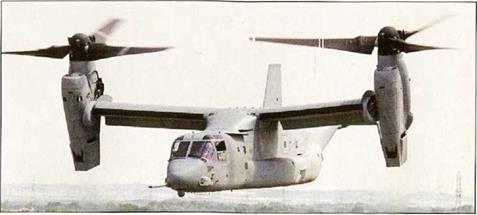Bell-Boeing V-22 Osprey
|
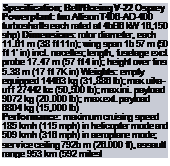 |
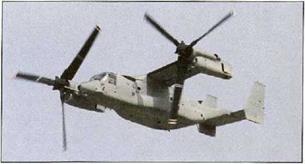 |
|
B |
ell Helicopter Textron and Boeing Vertol joined forces in the early 1980s to develop a larger derivative of the XV-15 tilt-rotor demonstrator for the Joint Services Advanced Vertical Lift Aircraft
(formerly JVX) programme. This effort was launched by the US Army and then transferred to the Navy in 1983. Combining the vertical lift capabilities of з helicopter with the faster forward flight efficiencies of a fixed-wing aircraft, the resulting V-22 Osprey (Bell Boeing Model 901) was awarded a full-scale development contract in May 1986. It is powered by two Allison T406 turboshafts driving three-b aded ‘proprotors through interconnected drive shafts. The wingtip-mounted engines, transmissions and proprotors can tilt Through 97° 30’ between forward flight and steep-descent or hovering flight. The blades and wings can also be quickly folded for stowage aboard aircraft carriers.
The first of five EMD prototypes flew on 19 March 1989 and the Osprey successfully demonstrated airborne transition from helicopter to wing- borne flight in September 1989. The fifth and final prototype flew on 11 June 1991.
Initial requirements called for 913 Ospreys; 552 MV-22A assault transports for the USMC; 231 similar variants for the US Army; 80 USAF CV-22As for long-range special forces transport; and 50 HV-22As for US Navy combat SAR_special warfare and fleet logistic support missions. The US Navy also foresaw a need for up to 300 SV-22A ASW versions.
During the 1990s plans for the Osprey changed dramatically as the programme was cut-back, cancelled, re-instated and cut back again. The USMC requirement has dropped to 360 MV-22Bs, whiie t. oe Navy plans to acquire 48 C-SAR-configured HV-22Bs in around 2010. All plans for US Army Ospreys have been dropped and while the USAF still has a notional requirement for 50 CV-22Bs, these aircraft may yet be cancelled,
In May 1997 assembly began of the first production – standard MV-22B. Thirty Ospreys have been ordered into low-rate initial production and deliveries began to the USMC in mid-1999. Marine Corps evaluation of the Osprey (conducted by VMMT-204) was blighted by several crashes. Two aircraft were lost on 8 April 2000 (killing 19 Marines) while a third crashed in December. The Nos 4 and 5 prototypes were involved in earlier accidents in 1991/92. While the crashes were not attributable to any inherent design flaws all Ospreys were grounded, and the future of the expensive and controversial aircraft has been called into question once more.
The V-22 has the ability to transition from vertical to horizontal flight, thanks to its revolutionary, but controversial, tilt-wing technology.
|
H |
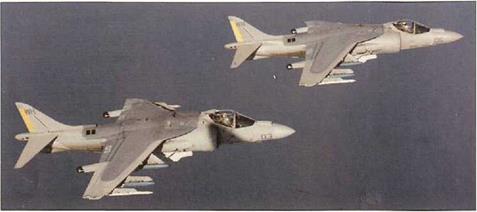 |
aving unsuccessfully pursued their individual programmes for an advanced successor to the RAF’s Harrier GR. Mk 3 and the USMC’s AV-8A Harrier British Aerospace (now 13AE Systems) and McDonne I Douglas (now Boeing) began to work on the joint Harrier II design. This radically revised aircraft featured a new, larger-ar&a carbon-fibre supercritical wing, a comp ete у redesigned, ralsed cockpit, and advanced aerodynamic lift-enhancing devices including LERXes and underfuselage lift – increasing ‘dams’. I he new wng was first flown on 9 November 1978, fitted to the 11th AV-8A (which became the first of two prototype YAV-8Bs>. The US Marine Corps took delivery of the first production AV-8B Harrier Ms in 1983,
From September 1989 (the 167th airframe on), all USMC AV-8Bs were made night-attack capable with the installation of a prominent FUR housing above the nose, a colour moving map and an improved HUD The term AV-8B (Night Attack) is often applied to these aircraft. For training, McDonnell Douglas developed the TAV-8B with a new forward fuselage, accommodating stepped tandem cockpits. Infernal fuel is reduced and to offset the reduced stability caused by the longer fuselage, the vertical fin is increased in area.
The distinctive FUR (Forward-Looking infra-Red) sensor above the nose is what gives the Night Attack AV-8B its 24-hour operational capability
The radar-equipped AV-8B Harrier II Plus is the ultimate evolution of the basic AV-8 Hairier design, which first flew (as the AV-8A) in November 1970
in 1987 McDonne! Douglas announced plans to develop з racar oquipped versior of tne AV-8B, the AV-8B Harrier II Plus In 1990 the US Navy authorised the development of a prototype and 24 product on aircraft. The first fully-equipped true prototype flew on?’? September 1992, The Hamer II Plus is fitted with the APG-65 multi-mode radar, giving it the capability to use radar-guided missiles, such as the AIM-120 AMRAAM, for the first time,
In 1992 the USA, Spain and Italy signed an agreement covering the joint development of the Harrier II Plus. The US Marine Corps has acquired a total of 27 new-build Harrier II Pluses, and a further 72 examples converted from existing AV-8Bs. The first Harrier II Plus was delivered to the Marines in July 1993, and the first remanufactured Harrier II Plus followed in January 1996. The Spanish navy purchased 18 aircraft to supplement its existing EAV-8B Harriers, while Italy bought 16 Harrier II Pluses, and two TAV-8Bs. The last Harrier II Pluses were delivered to Spain and Italy in July and December 1999, respectively.
In May 2000 Spain signed a deal to remanufacture two of its nine EAV-8Bs to Harrier II Plus standard, and plans to bring all its Harriers to this level. The first two rebuilt aircraft will be handed over in 2003.
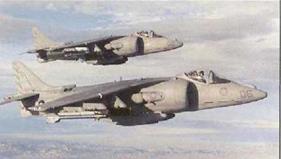
|











